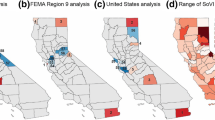Abstract
Typically, accessibility ratios have been calculated through a simple mathematical division of the number of people in an area by the number of facilities (or staff) in that area. This approach does not take into account the service area of the facility or its proximity to population centers, and is often performed using aggregate numbers for an administrative region. This paper describes an approach to calculating accessibility ratios such as population to facility ratios or population to staff ratios using Kernel density estimation (KDE) within a geographic information system. KDE disperses discrete phenomena across continuous space and is unrestrained by administrative boundaries. Therefore it provides a better representation of the spread of people and services across the landscape. Two types of accessibility ratios are calculated on a national level for Nicaragua: population-per-facility and population-per-staff; the merits of using KDE over traditional approaches are discussed.




Similar content being viewed by others
Notes
In 2001, the largest provider of health services in Nicaragua was the public sector. The private sector was composed of few facilities mainly concentrated in Managua, the capital city, and the two main largest cities, Granada and León.
The variance of the normal distribution is determined when the kernel size is chosen.
References
ArcGIS Software: Environmental Systems Research Institute, Redlands, CA, Version 9.0, (2004)
Carrothers, G.A.P.: An historical review of the gravity and potential models of human interaction. J. Am. Inst. Plann. 2, 94–102 (1956)
Chayovan, N., Hermalin, A., Knodel, J.: Measuring accessibility to family planning services in rural Thailand. Stud. Fam. Plann. 15(5), 201–211 (1984)
Gesler, W.: The use of spatial analysis in medical geography: a review. Soc. Sci. Med. 23(10), 963–973 (1986)
Guagliardo, M.F.: Spatial accessibility of primary care: concepts, methods and challenges. Int. J. Health Geogr. 3, 3 (2004)
Guptil, S.C.: The spatial availability of physicians. Proc. Assoc. Am. Geogr. 7, 80–84 (1975)
Joseph, A.E., Phillips, D.R.: Accessibility and utilization: geographical perspectives on health care delivery. Harper & Row, New York (1984)
Levine, N.: Crime Stat III Manual, CrimeStat: a spatial statistics program for the analysis of crime incident locations (v 3.0). Ned Levine & Associates, Houston, TX, and the National Institute of Justice, Washington, DC, (2004)
Ministerio de Salud and MEASURE Evaluation: Encuesta de Establecimientos de Salud: Nicaragua 2001. MEASURE Evaluation Technical Report Series No.13. Carolina Population Center. University of North Carolina at Chapel Hill, (2002)
Silverman, B.W.: Density estimation for statistics and data analysis. Chapman and Hall, New York (1986)
Acknowledgments
We thank Margel Beteta, Carlos Rojas and Luis Blandón for their assistance on the use of the Nicaragua census population data. This study was conducted with funds provided by MEASURE Evaluation which is a cooperative agreement (GPO-A-00-03-00003-00) between the U.S. Agency for International Development (USAID) and the Carolina Population Center, University of North Carolina at Chapel Hill. The opinions expressed are those of the authors and do not necessarily reflect the views of USAID or the United States government.
Author information
Authors and Affiliations
Corresponding author
Rights and permissions
About this article
Cite this article
Spencer, J., Angeles, G. Kernel density estimation as a technique for assessing availability of health services in Nicaragua. Health Serv Outcomes Res Method 7, 145–157 (2007). https://doi.org/10.1007/s10742-007-0022-7
Received:
Revised:
Accepted:
Published:
Issue Date:
DOI: https://doi.org/10.1007/s10742-007-0022-7




